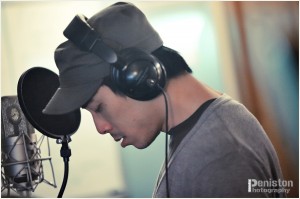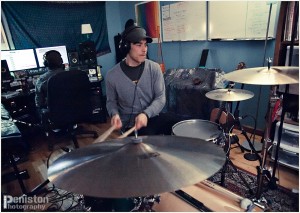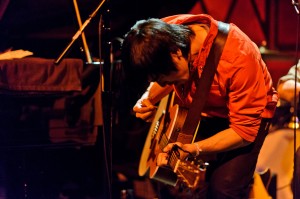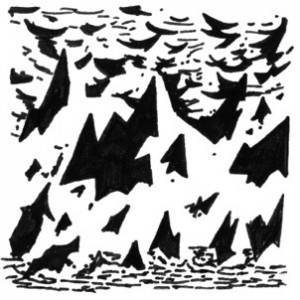The Perils of Self-Producing: 9 Things Alex Wong Learned Making “A City On A Lake”
WILLIAMSBURG, BROOKLYN:Who’s producing the producers? Since many of the women and men who helm recordings for a living are songwriters themselves, it’s inevitable that they’ll draw the tricky task of overseeing the production of an artistic album by a fellow producer.
Like one psychotherapist analyzing another shrink, or a National League pitcher serving up a fastball to the other guy on the mound, such reflective undertakings present unique mental challenges. As you can imagine, things get even more complicated when the producer you’re producing…is you.
That was the conundrum that the bicoastal producer/engineer/songwriter/multi-instrumentalist Alex Wong faced in the creation of the newly-released, self-titled album by his artistic alter ego, A City On A Lake. With a successful track record of producing/songwriting for the likes of Vienna Teng, Elizabeth & the Catapult, Melissa Ferrick, Delta Rae, Ximena Sariñana, and Ari Hest, Wong technically knew what he had to do to craft his own release – but he knew it wouldn’t be easy.
Taking things a step further, Wong not only completed the record – a spare, lush and beautiful collection of emotionally organic/electronic songs – but has been touring to promote the atmospheric album with a three-piece band. Accompanied on the road by Sariñana on keyboards and Kevin Rice on drums, Wong (who sang, played guitar, and drum machine on the dates) was reminded first-hand how the experience of a song can change from studio to stage.
Read on to see how the challenges of making his own record, and touring in support of it affected this emerging producer – and why Alex Wong believes his next clients will directly benefit as a result.
When you’re producing an album that’s your own, as opposed to having another artist’s name on it, how does that change the dynamic of your approach? And what stays the same?
I think that theoretically nothing changes, but in practice everything changes. And I would also say it was about a four-times-as-slow process: What I was going for artistically and the goals as a producer were the same, and I was still using the same criteria quality-wise and what I was shooting for. It just took me longer when I was producing my own stuff.
The reason it takes me longer is because I was the only one here for most of it. It was sort of me against myself. I wanted that challenge, but it was also more of a mental struggle, getting over personal barriers and the editing monster, and stuff like that.
A City On A Lakeis an imaginative record, very atmospheric, cinematic — and very much a studio album I’d say. When you made it, were you thinking ahead to its live presentation? Or does that not enter into the equation?
I think that I tend to approach the studio thing and the live thing very differently. I tend to ask the question of “Does it work?” in both scenarios, but what that means is often a very different thing. My goal is that the emotional content and the intention of the song come through on both a record and live, but I don’t try to recreate either one in the other medium. I’ve never really been into that.
I’ve never been somebody who said, “We have these string parts here, so we have to do that live, and we can’t track with too many instruments because we can’t recreate that live.”
Instead, you have this fun and difficult challenge, where you’re given a set of tools and you have to figure out what the vital elements are. You’re asking, “What is causing emotion in this song, and what can get those things across when we don’t have 48 tracks to work with?”
And the record is a very artificial environment, too. You can put something emotional high in the mix, like an acoustic guitar that wouldn’t necessarily be heard live over the other stuff. On the record you’re the master of time and space, and you can directly control so many scenarios.
You’ve been touring in support of this album, and will continue to tour. Do you think a producer/engineer approaches a live tour differently than an artist would?
Yeah, probably! I don’t think you can help it.
And I think there’s a lot more micromanagement. I’ve always thought of what I do live as more of live producing, because with Vienna Teng I was playing a bunch of different things, and I made a setup that was very specific to that set. I produced the (2009) record Inland Territory with full-on orchestral arrangements. Then we went to playing as a duo live, and all of that stuff went into a completely different setup.
Trying to figure out how those songs are going to work in that setup, the live set that we came up with was radically different from the record. We built things from the ground up, and finally Vienna wound up putting out a live record due to the radically different versions of the material we came up with that people loved.
When I create a live set, I come up with the fundamental things I’m looking for while producing, which are the emotional cornerstones of what you’re doing – it’s interesting how that seems to translate to the particular choices you make in a live setting.
For instance, with Vienna Teng, I used contact mics to do a lot of delays and looping things live to hint at an electronic feel, without using prerecorded tracks or anything like that. It’s about giving colors of that same feel, but not taking it so far that you’re locked into actual samples.
How did that prior experience directly affect the A City on a Lake setup?
So when we built the drumset for this project, one drum had a contact mic that was creating a lot of atmosphere, making wave sounds and looping them. It gave us sounds that make people think of electronically-influenced music, but with none of it actually being computerized, it feels a lot more organic.
And then for the bass, I’ve always been a fan of keyboard bass on the records, so that was easier to recreate. But as far as all the other parts, it was like, “OK, we have this part here that happens to be on a cello. Is that part necessary, or can something else happen in this section that’s important?” It’s cool to be able to break down each section, and ask yourself why something is there, rather than just insisting that it has to be there.
I do the same thing on a record. It’s asking yourself, “Why is this there? What it is it doing for me emotionally?” In that sense, I think the live producing is similar.
What adjustments did you realize you would have to make when taking these songs out on the road? What were some of the toughest decisions?
I don’t know if it was a tough one, but one decision I made was to make sure there was no laptop in the setup. I wanted to find a way to create everything in a live setting without going to a computer. I also wanted to keep it as a trio, which was another challenge.
For example on the song “Always Something Better”: That big intro on that song has a lot of different parts, and it builds and builds and builds, and we had to find a way to build it and maintain that level of excitement.
We said, “OK, we’ve got these three parts in this string arrangement that are important. What do we take out so it’s still possible to play?” So there was a lot of rewriting and adapting of the arrangement, to give it the same dynamic shape. Ximena (Sarinana) is already playing keyboards, synth bass, string pads, and also a little pocket piano. There’s only so much you can physically do (laughs)!
So we had to choreograph those parts. We’d have a held note live, whereas on the record it might be a more complicated part, but in the end the shape was the same. It was simplifying a part, but in a way that retained the same qualities.
How have these songs been surprising to you as you took them from the studio and put them out in front of people, live?
They started to get more energetic — they got faster a little bit — and we started to focus on different elements of the songs.
On the record I was focusing on the atmospheric qualities, making it a headphone record and a zone-out journey, but I think live the rhythms started to rock more (laughs). Their different qualities started to come out, and you began to see what songs would affect people live.
It was always a surprise. I started to sing the melodies differently live, and push different parts in a different way. It was really fun, and really encouraging! One thing I love is getting songs in front of people and seeing how differently they exist in that arena.
How does the live reaction inform you not just as an artist, but as a producer for when you go back into the studio?
You know what really is the most valuable thing for me, not as a live artist but as a writer? It’s that when you play songs for people in a live setting, you really know what parts don’t work.
If I play a recording for someone who’s just sitting there, I always know immediately – because I feel it myself – which parts lag or don’t keep someone’s interest. I always hear things differently when I’m listening with someone else.
The live show, as well, you feel how some things should be shaped. You’re riding this wave with the audience. You know where they’re engaged, or if the song’s too long. You get a lot of feedback, and it makes you a better writer or a songwriter.
It also definitely informs you as a producer, in terms of songcraft. To know when I’m doing something too self-indulgent, or something that just doesn’t work – that helps me to apply those lessons to someone else’s music, and listen to it more from an audience perspective and less of being in a vacuum.
This tour marks a transition for you from becoming Brooklyn-based to LA-based. What are you expecting as you make the move?
(laughs) Man, I just want to keep working! I’m so grateful. I feel it’s an end to a great growth period. I’m grateful I found my point of view, and really developed where I’m coming from as a producer and writer here in NYC, and got the chance to develop my craft and figure out what the hell I’m doing.
When I came to NYC, it was to learn, absorb art, and be pushed. Now my focus is a little more narrow going back to LA: I’m going there as a producer and I’m working with a manager out there. So what am I expecting? I don’t know, I want to continue to do great projects, and continue to work with great artists that I’ve been able to do out here. I’d like to be able to get into the community there, and have the same experience there as I have here, which has been so amazing.
You’ve lived and worked on both coasts. What’s the difference you see in the NYC and LA scenes?
I’ve been working a bunch there (in LA) in the past few years. When I left the first time, it was eight years ago and I was in a really different place.
Not that I’m more developed, my point of view has been expanded. I think that LA is a hard place if you’re just floating around, because from my experience, there’s a lot of inspiration out there, but you have to bring yourself to it. That’s as opposed to New York, where it hits you in the forehead as soon as you step outside.
That’s why people come here, to be inspired and intimidated by the great force that’s here. In NYC, you see people all the time in the subway: You see what they’re reading, the shoes they’re wearing, and you can’t help but pick up that information.
I used to slag on LA all the time, and there’s lots of things I don’t like about the place, just like there’s things I don’t like about here. But the creative scene there is always evolving, especially in the indie songwriter and indie band world, in ways that people can learn from. The fact is that great stuff is being made everywhere.
— David Weiss
Be absolutely sure to experience “Oceanside” from A City On A Lake:
Please note: When you buy products through links on this page, we may earn an affiliate commission.










